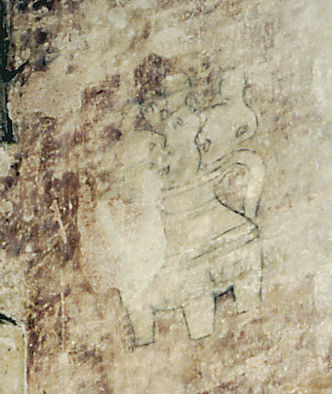Pickworth, Lincolnshire (†Lincoln) Late C14/Early C.15
Doom

The church was radically rebuilt in the mid fourteenth century, and this Doom has thus lost its top half. A new Doom was painted on boards fitted inside the chancel arch as at Wenhaston, but this was destroyed at the Reformation. The older painting was either invisible beneath whitewash at that time or ignored by the iconoclasts because it was too high to reach.
The Judging Christ has been reduced to the hem of his robe, his feet with nail marks clearly visible, and the orb of the world between his feet. This has been carefully divided into areas representing sea, dry land, and sky, and these details are clearer in the photograph of the right-hand side below. The lower half of a bare-legged figure kneeling to the right of Christ’s left (onlooker’s right) foot is John the Baptist, who usually (but by no means invariably) replaces John the Evangelist in Dooms from around the date of this one. Beside him is a standing figure, almost certainly an angel with Instruments of the Passion, and the vertical band separating him from Christ’s foot at the other side is the ‘end’ of the rainbow on which Christ originally sat.

Immediately below the end of the rainbow is a group of three or four tiny figures, all wearing shrouds knotted at the top of their heads, as at Great Harrowden. This is generally a fifteenth, not a fourteenth century detail – the sides of 15th century table-tomb monuments, especially in central England, sometimes feature this kind of ‘morbid’ sculpted detail. Two or three people are lying or standing up in their tombs around these shrouded figures.
To the right of these still-rising dead is a group of naked figures painted on a much larger scale – there are at least six of them, bound together with a chain. Beyond to the right, details are confused, but a group of smaller naked figures is visible at the extreme right, just before the return of the nave wall. They are standing inside what remains of a Hell-Mouth, and very faint indeed between this group and the larger-scale chained one stands a figure prodding them with a long lance or pitchfork, held diagonally. This looks more like a grinning figure of personified Death than a devil, but it is impossible to be sure.

This is not all. On the return of the south nave wall, and pictured below, is an enormous jug with a handle and three feet, presumably a cooking-vessel to be placed on a fire. There were once other painted details surrounding it, but these are now reduced to indecipherable patches. Notes in a document available in the church, written when the painting was clearer than it is now, speak of a devil stirring the jug-cauldron, and another above it with a chain, presumably for purposes of torture. There are certainly at least three people packed into the jug, their hands possibly bound behind them. No detail of fire underneath is visible now, but probably something like that was once there. The incongruous contrast between the homely domestic jug and the horrible eternal fate of the people in it could not be much more pointed.
The whole Doom must have been huge before the roof was lowered, and hugely terrifying as well. One consolation for the medieval onlooker might have been that the Virgin is as always prepared to intervene on behalf of the penitent sinner, but the Weighing of Souls where she is shown doing so is on the north wall, so I have dealt with it separately. The Pickworth Three Living and Three Dead is also now on the site.